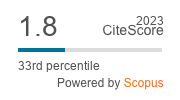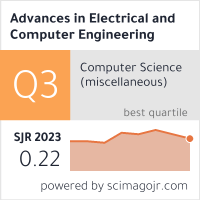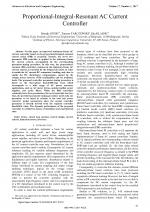| 1/2017 - 12 |
Proportional-Integral-Resonant AC Current ControllerSTOJIC, D. |
| View the paper record and citations in |
| Click to see author's profile in |
| Download PDF |
Author keywords
losed loop systems, control design, current control, induction motors, inverters
References keywords
current(19), control(17), electronics(15), power(8), industrial(8), induction(8), industry(6), applications(6), motor(5), model(5)
Blue keywords are present in both the references section and the paper title.
About this article
Date of Publication: 2017-02-28
Volume 17, Issue 1, Year 2017, On page(s): 81 - 88
ISSN: 1582-7445, e-ISSN: 1844-7600
Digital Object Identifier: 10.4316/AECE.2017.01012
Web of Science Accession Number: 000396335900012
SCOPUS ID: 85014140801
Abstract
In this paper an improved stationary-frame AC current controller based on the proportional-integral-resonant control action (PIR) is proposed. Namely, the novel two-parameter PIR controller is applied in the stationary-frame AC current control, accompanied by the corresponding parameter-tuning procedure. In this way, the proportional-resonant (PR) controller, common in the stationary-frame AC current control, is extended by the integral (I) action in order to enable the AC current DC component tracking, and, also, to enable the DC disturbance compensation, caused by the voltage source inverter (VSI) nonidealities and by nonlinear loads. The proposed controller parameter-tuning procedure is based on the three-phase back-EMF-type load, which corresponds to a wide range of AC power converter applications, such as AC motor drives, uninterruptible power supplies, and active filters. While the PIR controllers commonly have three parameters, the novel controller has two. Also, the provided parameter-tuning procedure needs only one parameter to be tuned in relation to the load and power converter model parameters, since the second controller parameter is directly derived from the required controller bandwidth value. The dynamic performance of the proposed controller is verified by means of simulation and experimental runs. |
| References | | | Cited By «-- Click to see who has cited this paper |
| [1] M. P. Kazmierkowski and L. Malesani, "Current control techniques for three-phase voltage-source PWM converters: a survey," Industrial Electronics, IEEE Transactions, vol. 45, pp. 691-703, 1998. [CrossRef] [Web of Science Times Cited 1392] [SCOPUS Times Cited 1977] [2] S. Fukuda and R. Imamura, "Application of a sinusoidal internal model to current control of three-phase utility interface converters," Electrical Engineering in Japan, vol. 150, pp. 54-61, 2005. [CrossRef] [Web of Science Times Cited 3] [SCOPUS Times Cited 2] [3] S. Buso, S. Fasolo, L. Malesani, and P. Mattavelli, "A dead-beat adaptive hysteresis current control," Industry Applications, IEEE Transactions, vol. 36, pp. 1174-1180, 2000. [CrossRef] [Web of Science Times Cited 147] [SCOPUS Times Cited 198] [4] D. G. Holmes, R. Davoodnezhad, and B. P. McGrath, "An improved three-phase variable-band hysteresis current regulator," Power Electronics, IEEE Transactions, vol. 28, pp. 441-450, 2013. [CrossRef] [Web of Science Times Cited 79] [SCOPUS Times Cited 91] [5] D. G. Holmes, T. A. Lipo, B. P. McGrath, and W. Y. Kong, "Optimized design of stationary frame three phase AC current regulators," Power Electronics, IEEE Transactions, vol. 24, pp. 2417-2426, 2009. [CrossRef] [Web of Science Times Cited 578] [SCOPUS Times Cited 686] [6] D. G. Holmes, B. P. McGrath, and S. G. Parker, "Current regulation strategies for vector-controlled induction motor drives," Industrial Electronics, IEEE Transactions, vol. 59, pp. 3680-3689, 2012. [CrossRef] [Web of Science Times Cited 143] [SCOPUS Times Cited 185] [7] D. N. Zmood and D. G. Holmes, "Stationary frame current regulation of PWM inverters with zero steady-state error," Power Electronics, IEEE Transactions, vol. 18, pp. 814-822, 2003. [CrossRef] [Web of Science Times Cited 1095] [SCOPUS Times Cited 1449] [8] T. M. Rowan and R. J. Kerkman, "A new synchronous current regulator and an analysis of current-regulated PWM inverters," Industry Applications, IEEE Transactions, vol: IA-22, pp. 678-690, 1986. [CrossRef] [Web of Science Times Cited 269] [SCOPUS Times Cited 358] [9] C. A. Busada, S. Gomez Jorge, A. E. Leon, and J. A. Solsona, "Current controller based on reduced order generalized integrators for distributed generation systems," Industrial Electronics, IEEE Transactions, vol. 59, pp. 2898-2909, 2012. [CrossRef] [Web of Science Times Cited 154] [SCOPUS Times Cited 198] [10] D. M. Stojic, M. Milinkovic, S. Veinovic, and I. Klasnic, "Stationary Frame Induction Motor Feed Forward Current Controller With Back EMF Compensation," Energy Conversion, IEEE Transactions, vol. PP, pp. 1-11, 2015. [CrossRef] [Web of Science Times Cited 19] [SCOPUS Times Cited 20] [11] L. Harnefors and H. P. Nee, "Model-based current control of AC machines using the internal model control method," Industry Applications, IEEE Transactions, vol. 34, pp. 133-141, 1998. [CrossRef] [Web of Science Times Cited 466] [SCOPUS Times Cited 590] [12] A. Petersson, L. Harnefors, and T. R. Thiringer, "Evaluation of current control methods for wind turbines using doubly-fed induction machines," Power Electronics, IEEE Transactions, vol. 20, pp. 227-235, 2005. [CrossRef] [Web of Science Times Cited 170] [SCOPUS Times Cited 229] [13] L. Zhang, R. Norman, and W. Shepherd, "Long-range predictive control of current regulated PWM for induction motor drives using the synchronous reference frame," Control Systems Technology, IEEE Transactions, vol. 5, pp. 119-126, 1996. [CrossRef] [Web of Science Times Cited 35] [SCOPUS Times Cited 55] [14] S. M. Yang and C. H. Lee, "A deadbeat current controller for field oriented induction motor drives," Power Electronics, IEEE Transactions, vol. 17, pp. 772-778, 2002. [CrossRef] [Web of Science Times Cited 65] [SCOPUS Times Cited 78] [15] R. D. Lorenz and D. B. Lawson, "Performance of feedforward current regulators for field-oriented induction machine controllers," Industry Applications, IEEE Transactions, pp. 597-602, 1987. [CrossRef] [Web of Science Times Cited 88] [SCOPUS Times Cited 134] [16] J. Jung and K. Nam, "A dynamic decoupling control scheme for high-speed operation of induction motors," Industrial Electronics, IEEE Transactions, vol. 46, pp. 100-110, 1999. [CrossRef] [Web of Science Times Cited 111] [SCOPUS Times Cited 176] [17] B. Bahrani, S. Kenzelmann, and A. Rufer, "Multivariable-PI-based current control of voltage source converters with superior axis decoupling capability," Industrial Electronics, IEEE Transactions, vol. 58, pp. 3016-3026, 2011. [CrossRef] [Web of Science Times Cited 165] [SCOPUS Times Cited 204] [18] L. Harnefors, K. Pietilainen, and L. Gertmar, "Torque-maximizing field-weakening control: design, analysis, and parameter selection," Industrial Electronics, IEEE Transactions, vol. 48, pp. 161-168, 2001. [CrossRef] [Web of Science Times Cited 163] [SCOPUS Times Cited 217] [19] M. Ruderman and T. Bertram, "Variable proportional-integral-resonant (PIR) control of actuators with harmonic disturbances," Mechatronics (ICM), 2013 IEEE International Conference, pp. 847-852, 2013. [CrossRef] [SCOPUS Times Cited 11] [20] I. Etxeberria-Otadui, U. Viscarret, M. Caballero, A. Rufer, and S. Bacha, "New optimized PWM VSC control structures and strategies under unbalanced voltage transients," Industrial Electronics, IEEE Transactions, vol. 54, pp. 2902-2914, 2007. [CrossRef] [Web of Science Times Cited 116] [SCOPUS Times Cited 166] [21] S. Fukuda and T. Yoda, "A novel current-tracking method for active filters based on a sinusoidal internal model [for PWM invertors]," Industry Applications, IEEE Transactions, vol. 37, pp. 888-895, 2001. [CrossRef] [Web of Science Times Cited 278] [SCOPUS Times Cited 340] [22] J. Holtz and J. Quan, "Sensorless vector control of induction motors at very low speed using a nonlinear inverter model and parameter identification," Industry Applications, IEEE Transactions, vol. 38, pp. 1087-1095, 2002. [CrossRef] [Web of Science Times Cited 298] [SCOPUS Times Cited 378] [23] A. G. Yepes, A. Vidal, J. Malvar, O. Lopez, and J. Doval-Gandoy, "Tuning method aimed at optimized settling time and overshoot for synchronous proportional-integral current control in electric machines," Power Electronics, IEEE Transactions, vol. 29, no. 6, pp. 3041-3054, 2014. [CrossRef] [24] Yepes, A. G., Freijedo, F.D., Loópez, O. and Doval-Gandoy, J., "High-performance digital resonant controllers implemented with two integrators, " IEEE Transactions on Power Electronics, vol. 26,, pp.563-576, 2011. [CrossRef] [Web of Science Times Cited 225] [SCOPUS Times Cited 276] [25] C. Xia, B. Ji and Y. Yan, "Smooth Speed Control for Low-Speed High-Torque Permanent-Magnet Synchronous Motor Using Proportional-Integral-Resonant Controller," in IEEE Transactions on Industrial Electronics, vol. 62, pp. 2123-2134, 2015. [CrossRef] [Web of Science Times Cited 194] [SCOPUS Times Cited 239] [26] A. Hasanzadeh, O. C. Onar, H. Mokhtari and A. Khaligh, "A Proportional-Resonant Controller-Based Wireless Control Strategy With a Reduced Number of Sensors for Parallel-Operated UPSs," in IEEE Transactions on Power Delivery, vol. 25, pp. 468-478, 2010. [CrossRef] [Web of Science Times Cited 85] [SCOPUS Times Cited 110] Web of Science® Citations for all references: 6,338 TCR SCOPUS® Citations for all references: 8,367 TCR Web of Science® Average Citations per reference: 235 ACR SCOPUS® Average Citations per reference: 310 ACR TCR = Total Citations for References / ACR = Average Citations per Reference We introduced in 2010 - for the first time in scientific publishing, the term "References Weight", as a quantitative indication of the quality ... Read more Citations for references updated on 2024-07-22 05:24 in 175 seconds. Note1: Web of Science® is a registered trademark of Clarivate Analytics. Note2: SCOPUS® is a registered trademark of Elsevier B.V. Disclaimer: All queries to the respective databases were made by using the DOI record of every reference (where available). Due to technical problems beyond our control, the information is not always accurate. Please use the CrossRef link to visit the respective publisher site. |
Faculty of Electrical Engineering and Computer Science
Stefan cel Mare University of Suceava, Romania
All rights reserved: Advances in Electrical and Computer Engineering is a registered trademark of the Stefan cel Mare University of Suceava. No part of this publication may be reproduced, stored in a retrieval system, photocopied, recorded or archived, without the written permission from the Editor. When authors submit their papers for publication, they agree that the copyright for their article be transferred to the Faculty of Electrical Engineering and Computer Science, Stefan cel Mare University of Suceava, Romania, if and only if the articles are accepted for publication. The copyright covers the exclusive rights to reproduce and distribute the article, including reprints and translations.
Permission for other use: The copyright owner's consent does not extend to copying for general distribution, for promotion, for creating new works, or for resale. Specific written permission must be obtained from the Editor for such copying. Direct linking to files hosted on this website is strictly prohibited.
Disclaimer: Whilst every effort is made by the publishers and editorial board to see that no inaccurate or misleading data, opinions or statements appear in this journal, they wish to make it clear that all information and opinions formulated in the articles, as well as linguistic accuracy, are the sole responsibility of the author.





